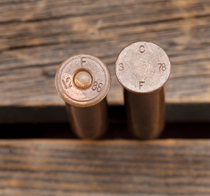
The 1873 was issued as an Infantry Rifle with full forend and 32 ½” barrel firing a 405-grain lead bullet at 1350 fps using 70-grains of Blackpowder hence the calibre name 45-70 Government. It’s interesting to note that Custer’s 7th Cavalry were one of the first units to be issued with the 1873 Carbine when they rode into history in 1876 at the Little Bighorn! That is not to say the 1873 was a bad rifle, but it initially had problems with its ammunition as the original cartridges were copper, which could swell in the breech and cause extraction problems. I believe it was always a one horse race and as the gun and ammunition had already been developed, so why waste it? After all the decision makers would not be the ones to use it! Unsurprisingly the 1873 Trapdoor Springfield was picked as the board decided that reliability was preferable to capacity. Some were single shot, others were magazine-fed.

Called the 1866 it saw limited service on the frontier and was gradually modified with the fifth variation showing the new 45-70 chambering.īetween 1872-1873 the US Ordnance held trails to determine a new rifle with the Springfield, Sharps, Peabody, Whitney, Spencer, Remington, and Winchester all being tested. 50” cal cartridge and a simple, flip-up breech system (trapdoor) was engineered for the rear, though still using a side-hammer. 58” and it was decided to turn them to breechloaders using a conversion by Erskine S. After the war the Union still had the 1863 Springfield rifled musket in. The majority of the fighting was done with rifled muskets like the Springfield and British Enfield. The Henry lever-action, Spencer and Sharps are good examples. In the American Civil War there were many repeaters and breech-loaders used on both sides in small amounts.


As risible as it might seem this is one of the reasons we British waited for so long to adopt a self-loading rifle after WW11 to replace our No 4 Enfields - the troops would doubtless shoot a lot more ammo and waste money.Īnother prime example was the US military’s evolution from muzzle-loading to breech-loading rifles. Ease of manufacture and economy probably being truer motives. Bean counters or bureaucrats call them what you will but providing soldiers with the right kit has never been high on their list of priorities. The procurement of military weapons has usually been done by those who don’t use them.


 0 kommentar(er)
0 kommentar(er)
